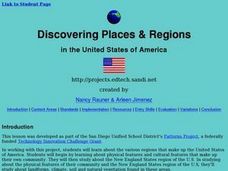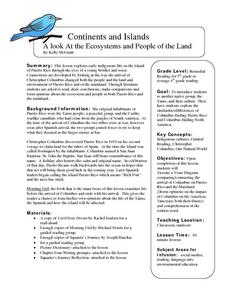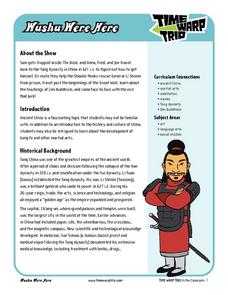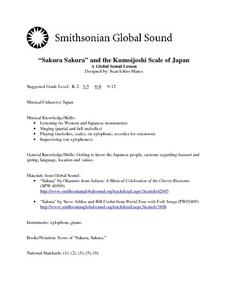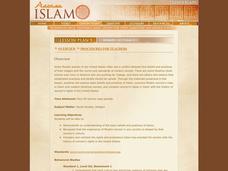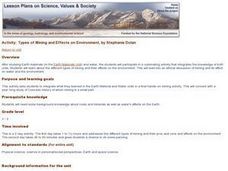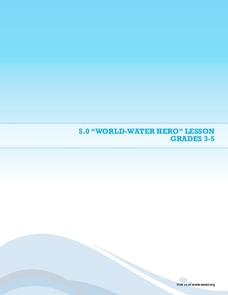Curated OER
Discovering Places & Regions
Fifth graders research physical and cultural features of a place. They practice skills in gathering information from various sources, using tools such as graphic organizers, word processing, multimedia, and use of the Internet.
Curated OER
How the West Was One: A Layered Book
Students create a layered book about the information they learn about the Western region of the United States. In this Western states lesson plan, students create a book about the land, economy, and culture.
Curated OER
Continents And Islands
Students engage in a literature study in order to address the concept of exploring the culture of Puerto Rico. The lesson looks at the culture through the eyes of two children. This helps students to connect to the content of the lesson....
Curated OER
Caribbean Beats and Blends: A Global Sound Lesson
Learners listen and respond to various forms of Caribbean music. In this music and culture instructional activity, students clap rhythms and respond to a sung call. Lyrics are analyzed for language blends and repetition. Music and...
Curated OER
How the Light Bulb Gets Switched On - The Evolution of Ideas
Students discuss how people are influenced by their cultures and backgrounds, make artwork that documents creative process, write character sketch of Colonel Massey from different points of view, examine issue from different perspectives...
Curated OER
The Bartered Bride
Students explore the ways music is used to convey ideas about a culture. They define folk art by viewing and comparing visual folk and fine art. Then they analyze the musical piece," The Bartered Bride" and relate it to how folk art can...
Curated OER
Wushu Were Here
Students create a fan-shaped story screen that explains 4 major points surrounding various facts, myths, expressions, or story elements in Chinese history, culture and/or literature.
Curated OER
Oh Picasso!
Students identify the painter Picasso as a famous Spanish cultural figure, name at least one of Picasso's painting styles and describe aspects of Picasso's Blue Period. They create their own Blue Period inspired work of art.
Curated OER
Rap as a Modern Poetic Form
Students write and listen to rap songs. They discover how common themes in rap are indicative of the problems, as well as the empowerments, that can be seen in our urban cultures today. They discover how rap is actually an evolution of...
Curated OER
Mysteries of Egypt
Students investigate the Egyptian civilization. In this cultural lesson, students watch the film Mysteries of Egypt and create a replica of an ancient Egyptian artifact.
Curated OER
"Sakura Sakura" and the Kumoijoshi Scale of Japan
Young scholars listen to a recording of "Sakura" and determine where it is from. In this global sound lesson, students view pictures of cherry blossoms and connect its significance to Japanese culture. Young scholars sing the score while...
Education World
Thinking About Thanksgiving: Lessons Across the Curriculum
Bring two integrated curriculum resources about Thanksgiving to an elementary social studies unit. The first activity focuses on Squanto's contributions to the early Pilgrims' survival with a gardening activity in which learners add...
Global Oneness Project
Deconstructing Consumerism
To increase awareness and launch a discussion of consumerism, class members view What Would It Look Like, a 25 minute film of images that capture the global effects of the consumption of goods. Viewers make a list of the images that...
Curated OER
How Does the Air Get Polluted?
Students listen to or read a story that introduces awareness of environmental issues and in particular pollution.
Rainforest Alliance
Forests of Guatemala
With 90 percent of its land area covered in forests, Suriname, a country in South America, contains the largest percentage of forests throughout the world. Here is an activity that brings classmates together to learn about the...
Curated OER
Communication and Social Networks
Pupils work in cooperative groups to explore communication needs of our world. They are assigned a demographic area and asked to create ways to solve communication problems with innovative ideas. They also explore areas that can help...
Curated OER
How Many Wives?
Students explore how religious texts are often used to establish cultural norms and rules of behavior. Through research and discussion, students explain how religious texts can be open to interpretation. Students can apply their research...
Curated OER
Women In Islam
Students identify the basic beliefs and practices within Islam. Using a specific country's culture, they discover the experiences of Muslim women differ between countries. They compare and contrast the rights and protections Islam...
Curated OER
Getting Oriented
Students explore the geography, culture, and philosophy of Asia using all five senses and information about China and Japan. This lesson is detailed and may take several days of in-class activities to complete.
Curated OER
Jewish Assimiliation in Contemporary American Literature
Students read a collection of stories and watch videos to learn about the Jewish assimilation in American literature. In this American literature lesson plan, students watch videos about Judaism, read stories from a contemporary Jewish...
Curated OER
Social Studies: Your Family Does What?
Sixth graders compare and contrast their own personal culture with that of Japan. They fill out questionnaires, compile the results, and match them with Japanese answers to the same forms. Students create a Venn diagram of the...
Curated OER
Native American
Students investigate how early European exploration and colonization resulted in cultural and ecological interactions among previously unconnected peoples. They comprehend that Europeans had misconceptions about Native American literacy...
Curated OER
World-Water Hero
Students make up a superhero. In this water quality lesson, students create a superhero with super powers that can improve water quality and availability.
Curated OER
Myths and Legends on Natural Disasters: Making Sense of Our World
Students explore different natural and manmade disasters through a webquest. In this earth science lesson, students explain their causes. They also discuss how disasters affect society.
